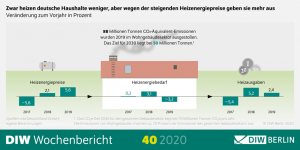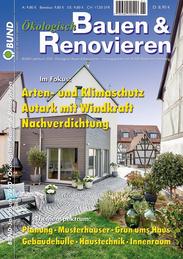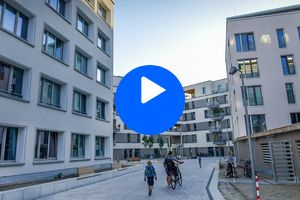Recommendations from the BMBF project "Urban Heat Transition" were published: ► Consistently tapping alternative heat sources such as wastewater heat ► Convert public buildings to renewable heat and create neighbourhood heating networks ► Ambitious energy refurbishment in neighbourhood conservation areas to keep rents affordable
Kategorie für Blog: Thermal insulation
 To live up to its climate change pledge under the Paris Agreement, the European Union must ensure that all 250 million existing buildings, as well as all new buildings in the EU, produce near-zero greenhouse gas emissions. In a new report, European national academies of science, through their association EASAC, call for far-reaching policy action. "Policies have long focused on creating energy-efficient buildings that require less heating and air conditioning or generate renewable energy on site. However, the energy used to operate buildings is only part of the story. We need to broaden the scope and look at emissions from building materials and methods - both for new buildings and for building refurbishment," says William Gillett, Director of EASAC's Energy Programme.
To live up to its climate change pledge under the Paris Agreement, the European Union must ensure that all 250 million existing buildings, as well as all new buildings in the EU, produce near-zero greenhouse gas emissions. In a new report, European national academies of science, through their association EASAC, call for far-reaching policy action. "Policies have long focused on creating energy-efficient buildings that require less heating and air conditioning or generate renewable energy on site. However, the energy used to operate buildings is only part of the story. We need to broaden the scope and look at emissions from building materials and methods - both for new buildings and for building refurbishment," says William Gillett, Director of EASAC's Energy Programme.
Exploit potential at neighbourhood level!
The KfW programme "Energy-efficient urban refurbishment" promotes integrated energy-efficient neighbourhood concepts and refurbishment management with programme part 432. Programme parts 201 and 202 provide investment support for cross-building and infrastructural supply systems. The Federal Ministry of the Interior, for Building and the Home Affairs provides the funding for the energy refurbishment process from the individual building to the neighbourhood from the Energy and Climate Fund (EKF). Annual DIW Heat Monitor based on data from energy service provider ista Deutschland GmbH: Heating energy demand in residential buildings declines again for the first time since 2015 - Rising prices, however, cause heating expenditure to increase by 2.4 percent - CO2emissions have fallen by 21 percent overall since 2010, but by only 2.6 percent when adjusted for temperature - Energy-efficient renovation in residential buildings almost stagnant
Annual DIW Heat Monitor based on data from energy service provider ista Deutschland GmbH: Heating energy demand in residential buildings declines again for the first time since 2015 - Rising prices, however, cause heating expenditure to increase by 2.4 percent - CO2emissions have fallen by 21 percent overall since 2010, but by only 2.6 percent when adjusted for temperature - Energy-efficient renovation in residential buildings almost stagnant
Climate protection has long been one of the most urgent topics for the housing industry. In order to achieve a climate-neutral building stock by 2050, the 24 founding companies of the Wohnen.2050 initiative met in Berlin on 28 January 2020 to found the association. The nationwide association was initiated by the Nassauische Heimstätte | Wohnstadt group of companies.
 "Don't just talk about climate change, act" - under this motto, the Nassauische Heimstätte | Wohnstadt Group invited founding partners from all over Germany to found the Initiative Wohnen.2050 (IW2050) association. The overarching objective is a climate policy alliance, which, in addition to strategic cooperation and a technical and content-related comparison, primarily focuses on economic and financial concerns to achieve the targets.
"Don't just talk about climate change, act" - under this motto, the Nassauische Heimstätte | Wohnstadt Group invited founding partners from all over Germany to found the Initiative Wohnen.2050 (IW2050) association. The overarching objective is a climate policy alliance, which, in addition to strategic cooperation and a technical and content-related comparison, primarily focuses on economic and financial concerns to achieve the targets.
A research project conducted by natureplus in conjunction with IFEU compares insulation materials with regard to their environmental impact throughout their entire life cycle, including recovery and recycling.

 Which insulation material is the best? This question is extremely popular in the construction industry and can ultimately only be answered in the context of the respective construction. In particular, there has so far been a lack of a holistic overview that enables builders and planners to identify the strengths and weaknesses of the various insulation material alternatives in terms of their life cycle assessment, without having to disregard subsequent disposal.
Which insulation material is the best? This question is extremely popular in the construction industry and can ultimately only be answered in the context of the respective construction. In particular, there has so far been a lack of a holistic overview that enables builders and planners to identify the strengths and weaknesses of the various insulation material alternatives in terms of their life cycle assessment, without having to disregard subsequent disposal.
Germany's largest cooperative housing project in Berlin 28:58 min Video available until: 12/02/2020 First broadcast on: 2.12.2019 Living in the metropolis, in a large community, according to its own rules. Central, energy-saving, ecological, cosmopolitan, inclusive. The residents of Möckernkiez in Berlin-Kreuzberg have fulfilled this dream.
Senate adopts concrete measures for the next ten years and sets new CO2-targets for 2030 and 2050
The project, initiated by the Bund für Umwelt und Naturschut The BUND Yearbook Ecological Building & Renovation, published by BUND Deutschland (BUND), helps by making owners fit for discussions with the house bank, architect, energy consultant and craftsmen. The guidebook, which will be available from November, shows what can be done and how: Based on numerous house portraits, the annual compendium helps the reader to find out which measures, building materials and technologies are best suited to their own project.
The BUND Yearbook Ecological Building & Renovation, published by BUND Deutschland (BUND), helps by making owners fit for discussions with the house bank, architect, energy consultant and craftsmen. The guidebook, which will be available from November, shows what can be done and how: Based on numerous house portraits, the annual compendium helps the reader to find out which measures, building materials and technologies are best suited to their own project.
24 October 2019 Strengthen energy refurbishment of buildings and demand responsibility from landlords. Housing policy must create supportive framework conditions and thus contribute to the reduction of living space. "For a necessary energy turnaround in the housing industry, conditions must be created that demonstrate tangible incentives for owners and users to consume less energy in the future," [...]
Refurbishments or energy-efficient new buildings Name: 10,000-Häuser-Programm - EnergieBonusBayern Type of support: Grant Amount of support: Up to EUR 18,000 per housing unit Provided by: Bavarian State Government Area of application: Bavaria With the EnergieBonusBayern, the Free State of Bavaria supports innovative homeowners and developers who carry out energy modernisation measures on existing residential buildings or construct new energy-efficient residential buildings. The subsidy applies to [...]
The Agency for Renewable Resources (Fachagentur Nachwachsende Rohstoffe e. V. - FNR) supports potential applicants in applying for funding with a guideline for submitting outlines and applications for projects in the field of the Forest Climate Fund. (FNR) supports potentially interested parties in applying for funding. The guide is available in print and for download. The 58-page brochure in A5 format provides condensed information on the funding procedure and explains [...]
BUND and the ifeu - Institute for Energy and Environmental Research have produced various studies on building issues over the last 10 years, including "13 measures against energy waste in the boiler room". This study now deals with the core issue of cost allocation for energy modernisation in rented buildings. Already in the year [...]
BauInfoConsult surveyed 6,000 architects On the insulation market, so-called "natural" insulation materials such as wood wool, hemp, cork, granulates and co. are still niche products. However, they are on the rise throughout Europe, at least from the point of view of architects: According to a survey of 1,600 European planners, the use of natural insulation materials is likely to increase in seven of [...]
Deutsche Umwelthilfe calls for immediate proposal for tax incentives for energy-efficient building refurbishment - Building sector makes decisive contribution to achieving climate protection targets - Increase refurbishment rate to 2 percent per year In the draft budget presented by Federal Finance Minister Olaf Scholz on 2 May 2018, the tax incentive [...]
Since 1999, ABG Frankfurt Holding has built around 3,000 apartments in passive house standard for residents from 180 nations, ranging from subsidized apartments to condominiums. Due to the low ancillary costs and the high living comfort, there are hardly any vacancies. "We build cheaper than the competition, which either doesn't want or can't do Passive House," [...]
Incentive for less "grey energy" in the construction of non-residential buildings The City of Hamburg promotes the use of wood in the construction of new non-residential buildings with a floor area of 100 m² or more. The use of wood in the construction of new buildings is subsidised with € 800 per tonne of wood product.
Since the first edition of the FNR brochure "Straw Insulated Buildings" in 2013, building with this environmentally friendly and cost-effective material has developed positively.
In its August issue, ÖKO-TEST magazine evaluated 15 different roof insulation materials, including 5 with the natureplus seal of approval. The products are mainly suitable for insulation between rafters. The good performance of conventional products made of glass and rock wool, which all achieved "good", was striking. Of the natureplus-certified products, 2 insulation materials made of wood fibres - "Gutex Thermoflex" [...]
Some cities subsidize the use of certified insulation materials with a bonus to support resource conservation, carbon storage and particularly environmentally friendly products. This also includes many insulation materials made from renewable raw materials. The overview lists the cities that grant an extra subsidy for certified natural insulation materials: Düsseldorf 10 - 25 EUR/m² Hamburg 10 EUR/m² Hanover [...]
In the Federal Republic of Germany, more than 720 million square metres of building space have been covered with polystyrene since the Second World War. Now, according to manager magazin, a series of major fires in the industry has startled the insurance industry. According to the report, the insurance industry is now openly advising against the use of Styrofoam not only as an insulating material for commercial buildings, but also [...]
To date, over 500 neighbourhoods have applied for funding for energy-related neighbourhood concepts. A new brochure and a travelling exhibition present practical examples and recommendations for implementation.
The flame retardant HBCD, which was mainly used in polystyrene insulation boards, has been banned since March 2016. But trouble looms from the many millions of cubic metres of HBCD-containing insulation material that have already been installed in Germany. The flame retardant hexabromocyclododecane (HBCD) has been largely banned from trade and use in the EU since spring 2016. HBCD was [...]
The largest passive house development in Europe is currently being built on Mühlenweg in Vienna. The total area of the Aspanggründe "Eurogate" site covers approx. 22 ha. Six different architectural firms are planning a total of 740 apartments. In the final stage, approx. 7,000 jobs will be created there. By the end of 2008, around 25% of the planned social housing in Vienna will probably be of passive house standard [...]





